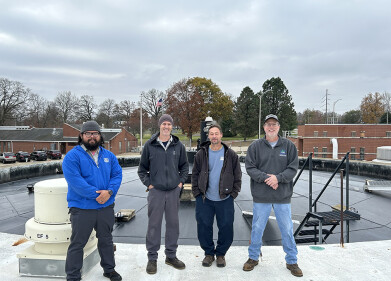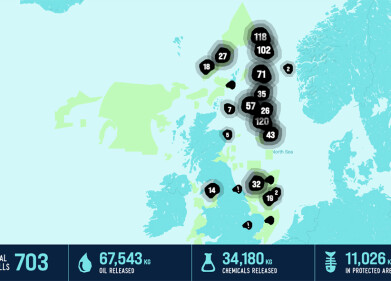Water/Wastewater
Keeping Ammonia and Nitrates in Check
Oct 31 2017
A Lincolnshire meat processing firm was fined £15,300 in 2016 for toxic levels of ammonia in its wastewater. Here, Steve Martin, projects director of wastewater and biologicals at NCH Europe, explains why regulations on ammonia, and its partner in crime, nitrate, are so tightly controlled by water companies.
The levels of ammonia recorded in the watercourse of the fined Lincolnshire meat processing firm far exceeded acceptable levels, with a concentration of 207mg/l found in the immediate effluent. In comparison, clean river water has ammonia levels less than 1mg/l. These toxic levels still remained prevalent 3.5km downstream, with levels of 39.8mg/l recorded, showing wide spread effects.
This case isn't out of the ordinary. Other companies have also been hit with five-figure fines for polluting local watercourses. It is incidences such as these where necessary site management strategies haven't been put into place. Ignorance is not an excuse for being negligent and failing to take reasonable care of our environment, and the lesser mentioned sewer system.
The Urban Wastewater Directive, adopted in 1991, sets the standards required to protect the environment from adverse affects of industrial wastewater discharges. The directive also defines sensitive areas that are vulnerable to adverse ecological changes if protective action is not taken.
Nearly all the water used by industry is discharged into underground sewers and transported to many sewage treatment works around the country. It is here that water is treated to meet regulatory standards before it can re-join streams, rivers and oceans. With the volumes and variance that comes from industrial effluent, this is no easy task.
Food processing, energy and pharmaceutical companies have wastewater streams assessed by their water providers every month. Many parameters are considered, ultimately judging how expensive it will be to clean this water, and recovering these costs from the perpetrator. Effluent volume, chemical oxygen demand (COD) and suspended solids (SS) are measured in this monthly bill, calculated using the Mogden formula.
Ammonia is a by-product of organic waste as it decomposes in the water. If new environmental requirements are introduced, the Mogden formula will be modified to recover the costs of additional treatment, such as ammonia removal. This reinforces that time is of the essence to put ammonia reducing strategies into place, to save huge sums of money from bills, or worse — fines.
Not only is ammonia toxic in watercourses, it results in an unsafe environment in sewers and sewage systems. Ammonia contributes to sewer gas, a highly dangerous build up of gases that has the potential to cause explosions. Additionally, if inhaled, these gases start to replace oxygen in the blood stream and lungs of the many different workers in the sewer vicinity, potentially causing severe health problems.
Nitrogen takes on different forms as part of the nitrogen cycle, as part of an important environmental process. Nitrogen combines with other chemicals, with the help of bacteria in the water, to form new compounds. As part of this cycle, nitrifying bacteria convert ammonia into nitrates in a two-step chemical reaction. While nitrates aren't toxic like ammonia, unfortunately they come with their own set of problems.
ammonia - nitrite - nitrate
(nitrifying bacteria)
Nitrates are an important building block to life, but too many are disruptive to the water ecology. High nitrate levels in water ecosystems may cause harmful algae blooms, leading to rapid decrease of oxygen and available food, water toxicity and poisoning, and slime and foam formation, rendering the environment lifeless.
There are designated Nitrate Vulnerable Zones (NVZs) across the country, as part of the Nitrates Directive of 1991. The department for Environment, Food and Rural Affairs (Defra) has sent written notices in 2017 to any person who occupies land within an NVZ, explaining their obligation to comply with NVZ rules. This covers about 58 per cent of land in England, meaning many businesses face this obligation.
With water companies and environmental inspectors hot on the trail of both ammonia and nitrate levels, it is of crucial importance to immediately implement onsite management strategies to treat wastewater streams effectively, and save huge sums of money in the long-term.
One of the most efficient solutions that not only reduces ammonia and nitrate concentrations, but also a range of Mogden parameters, is bacteria wastewater treatments, such as NCH Europe’s FreeFlow bacteria service. These bacteria are naturally occurring and environmentally friendly. They digest organic waste, such as fats, oils and greases (FOG), metabolising them into carbon dioxide and water — much less harmful to the environment than ammonia.
These completely natural and food safe bacteria digest organic waste before it has a chance to decompose and release ammonia. This simple yet effective approach reduces ammonia concentration in trade effluent, and in turn reduces nitrates as less ammonia is available to be oxidised into nitrates.
For companies looking for the next 'green' step to maintain ISO standards, introducing a BioAmp dispenser that automatically doses FreeFlow bacteria to wastewater streams is a great way to proactively exceed wastewater regulatory standards and save money in the process. With this BioAmp service, monthly effluent disposal fees are reduced between 10 to 30 per cent.
The aforementioned Lincolnshire meat processing case is not a standalone case by any means, and inevitably other companies will face similar fines if they commit the same environmental offences. Companies should look to tackle any issues quickly, to reap monthly cost savings as soon as possible.
Events
Apr 15 2025 Moscow, Russia
Apr 21 2025 Shanghai, China
May 11 2025 Vienna, Austria
May 18 2025 Algiers, Algeria
23rd International Water Management Exhibition
May 20 2025 Prague, Czech Republic
.jpg)













